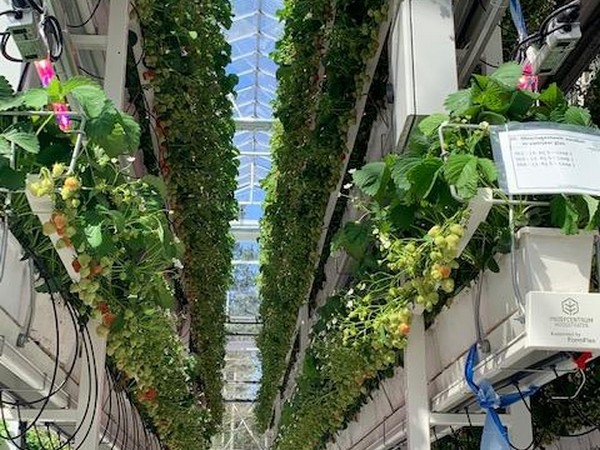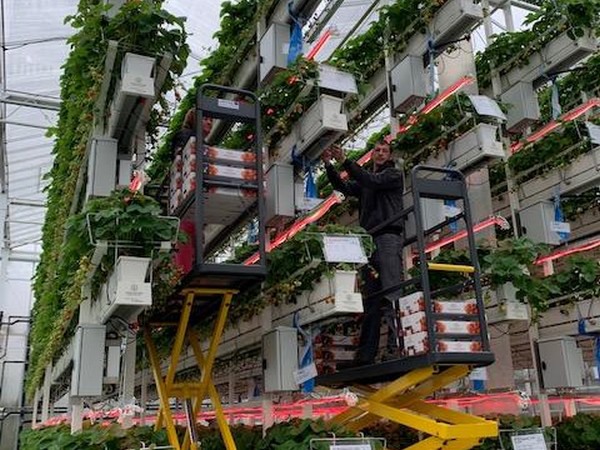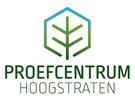The multi-tier cultivation of strawberries at Proefcentrum Hoogstraten is in full swing. At the end of January, the strawberries were planted and if all goes well, this fall another cultivation will be started so the growing can continue. Roel Vanderbruggen, manager at the Proefcentrum, talks about how the cultivation is doing and what the challenges and opportunities are. Last fall, new LEDs (Floralux, from Luminaid) were installed, so there is now a capacity of 255 µmol/s/m². The top tiers get 90% of the light, and the lower in the tiers, the higher the intensity.

Research project
The multi-tier cultivation is a challenge, of which not much is known yet. “In a project, you have to start with your base knowledge, and try to enhance this by trial and error,” explains Roel. Maximal use of space is certainly a goal, since greenhouses are built higher. Another important goal is lowering the energy use per fruit grown.
Creating more production per surface unit with the same use of energy, means (energy) profit. Also, the production can be enlarged, without needing to build a new greenhouse. “We are going to apply all the aspects of strawberry cultivation on this – spring growing, an ongoing season and winter growing. With that, we will constantly look at production, quality, taste and brix.” The multi-tier cultivation is part of a research project of Interreg Vlaanderen-Nederland (GLITCH).
COVID-19
Because of the Coronavirus, the borders are still closed and so is the company. The staff did work on, taking into consideration the necessary measures, of course. Most people are at home as much as possible, so there are very little applications for a visit. “When the measures are lifted, visitors are welcome, but with application beforehand and with the hygiene measures that are standard here, and will be kept later as well.”
Challenges and opportunities
The biggest challenge in the cultivation is the climate. All practical issues have been resolved, so those are gone. “Because we have tripled the plant capacity, we have way more moisture in the greenhouse. We see that on a day with little sunlight, it’s very hard to get this out of the greenhouse,” tells Roel. More energy is needed to dehumidify.
A second issue is the vertical temperature distribution. This isn’t optimal yet. Roel: “We already have some Vertifans (vertical fans) in the greenhouse, but they aren’t enough. This is something we need to work on for the future.”
“We don’t have a crystal ball, and like with many research projects this isn’t the right time yet, but there is definitely a future for this system,” tells Roel. “Maybe not in this exact setup, but that is up to the innovativeness of growers and suppliers.” What about other crops? “It’s not our core business, we are more specialized in strawberries, tomatoes and bell peppers, but the multi-tier cultivation is certainly suitable for other crops like lettuce or herbs.”

Commercial cultivation
“The motto of a research institution has to be, that the possibilities and the problems are exposed first, before the commercial viability is checked,” says Roel. With LED in tomato cultivation people also asked if it wouldn’t be too expensive for the commercial cultivation. After intense research by the Proefcentrum they could answer virtually every question the growers had, and LEDs are now installed on multiple hectares and this is still expanding. “There are also tests with LED in bell pepper cultivation, with good results. Whether these systems are financially viable, that isn’t a question for us, that’s a question for the growers,” says Roel.
For more information:
Proefcentrum Hoogstraten
Voort 71
2328 Meerle, België
Tel: +32 (0)3 315 70 52
Fax: +32 (0)3 315 00 87
[email protected]










